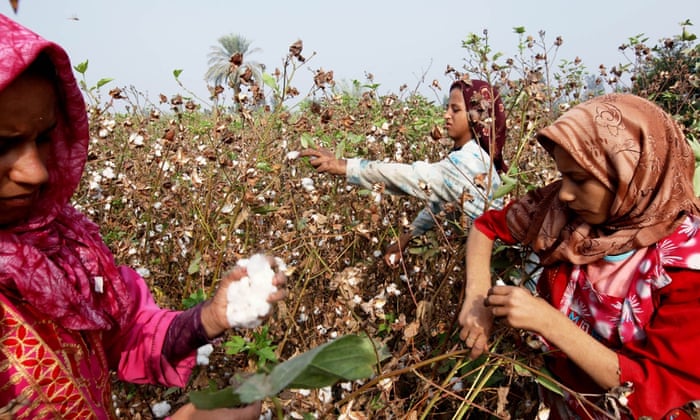Sustainable material pioneers: what does the future hold?

What’s wrong with the materials I’m wearing now?
It’s likely that you’re wearing cotton or polyester, two of the fashion industry’s most popular fibres. Cotton depends on large amounts of water to grow, and polyester depends on now-declining reserves of oil and gas. The idea behind sustainable materials is that they are less damaging to the environment to produce, consuming fewer natural resources and creating less pollution.
Erin Smith, artist in residence at Microsoft Research explains:
But what would we use instead of cotton?
Bamboo, linen, hemp, sisal and even nettles are being looked into as alternatives to cotton, says Susan MacDonald, business development director at CottonConnect. Bamboo is quick to grow and easily renewable, and linen, hemp and sisal use less water and pesticides than cotton.
However, these alternatives are grown in small volumes, so they’re more likely to reduce dependency on cotton than replace it. These fibres also have different properties compared to cotton and MacDonald suggests their success is linked with the spinner industry and spinning technology.
Flax, (a stalky plant) also has potential, requiring far less water than cotton crops demand. According to Christian Wieth of Novozymes, the biotechnology company is part of research initiatives on making flax more cotton like but “it remains several years before it becomes commercially relevant in larger scale”.
Nevertheless, with cotton prices at a high, hitting $2 a pound for the first time in 2011, the economic driver for investments in alternatives is there.
Are there sustainable alternatives to leather?
Brooklyn-based Modern Meadow is developing slaughter-free, lab-grown leather in a process that could dramatically reduce methane emissions and water and land use.
In the case of fish leather, Heidi Carneau, director of eco-exotic leather brand, Heidi & Adele, says that for a young technology, there has been tremendous innovation in the area with a variety of new finishes and colours to show for it.
She admits though, that price is a hurdle.:“In our case we use salmon and eel skin, both byproducts of the food industry to make our handbags.
Salmon leather is actually more expensive than python skin. This cost is directly linked to the high expertise required to work the skin and the fact that this fish is farmed in countries such as Iceland where labour costs are much higher.”
Wait, lab-grown leather? So we can grow clothes in the lab?
Smith - who grew her own wedding dress - believes bio-materials could make a huge sustainability impact in the future, particularly as they relate to questions of limited availability materials. She says, “there are some companies like Pembient, who are working to develop lab grown ivory, who will be creating a luxury product in a sustainable way, and helping to combat other ecological problems such as illegal poaching”.
What’s best for fast fashion - materials from food byproducts or recycled cotton?
Both will offer very different finished products but have a place in sustainable fashion. Recycled cotton can be integrated immediately while food related fibres and materials are currently more conceptual.
For H&M, recycled cotton is a more useful fibre, explains Cia Sohlman, who is responsible for the high street brand’s sustainable materials strategy and development. “We have used recycled cotton in denim [and] we are trying to expand the use into other products like jersey and heavy knit, but since recycled cotton has shorter fibres it is a quality issue to find the right blends.”
How can designers weigh up the pros and cons of different materials?
The Sustainable Apparel Coalition is developing the Higg Index as a tool to gauge the environmental sustainability performance of materials, which Sohlman thinks could help in the future. While not-for-profit, Made-By, has made its own sustainability classification of materials.
For Carneau, it simply comes down to research. “You must immerse yourself … It took us a year to ascertain we were in line with the ethics and methods of our suppliers and manufacturers.”
Wieth of Novozymes would like to see designers focus more on the durability of their garments. “Specifying a high garment quality in terms of having no fuzz and pilling (bobbles) is one critical element … and [the] use of biopolishing is the most sustainable manner to do this,” he writes.
People still associate sustainability with beige ugly fashion, don’t they?
MacDonald thinks “the ugly beige era has passed (thankfully).” However, she adds that sustainability must be better communicated so it’s not considered a compromise. “Two major European retailers are both the top two users of organic cotton globally (pdf) and still produce desirable and wearable collections for their consumers, but do not shout loudly about this.”
Carneau also believes sustainability is making a more fashionable name for itself thanks to people such as Livia Firth and Stella McCartney. But, she says that for new smaller brands, communication is a problem. She explains that new sustainable brands don’t have the marketing and advertising power that big luxury brands do, which makes it difficult to create the same “aura” as luxury brands.
So, what next for sustainable materials?
CottonConnect’s MacDonald says, “when we look back 10 years ago, there were no smart phones, so technology moves at an alarming pace. For clothing, by 2025, sustainable cotton options will no longer be discussed, as they will be a major part of the cotton market, and [simply] business as usual.”
For Giusy Bettoni, CEO and founder of Class, sustainable materials have yet to “take off” but their introduction into the market has definitely started. In the years to come she says we will finally have a new material portfolio that will not be only natural, organic, synthetic and artificial, but include re-generated, re-engineered and upcycled fashions.
Isn’t our rate of consumption the problem? How will sustainable materials help that?
Smith observes that we’re already seeing certain consumer groups move towards a less throwaway relationship with fashion and that buying patterns will change in time, but we must first address the sustainability of the materials we use.
Taking consumption rates into consideration and finding post-consumer recycling solutions will be hugely important for the sustainability of the fashion industry. Sohlman says that with research and innovation, it’s H&M’s hope that it will eventually be possible to close the loop on material waste.
For Kate Fletcher, a professor, author and sustainability consultant, more promising materials are part of a radical root and branch reform of the fashion industry’s practices, but they’re only the beginning. “However great our material choices, they change little if the bigger systems and structures of consumerist fashion remain unaffected.”

Comments
Post a Comment